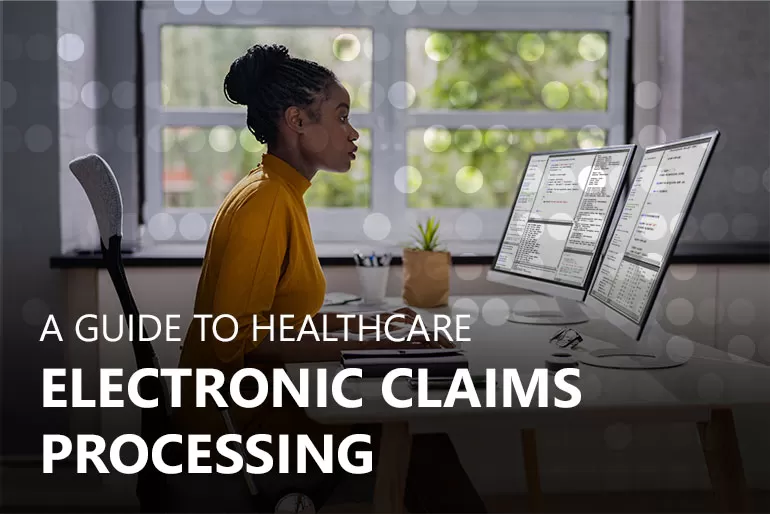Originally published September 27, 2019
Technology has dramatically changed the way healthcare organizations, including providers and payers, operate. It has also made a marked difference in medical billing processes such as claims processing.

Electronic Claim Definition
A major change for the medical billing industry occurred with the adoption of electronic claims, which the American Medical Association defines as a paperless patient claim form generated by computer software that is transmitted electronically over telephone or computer connection to a health insurer or other third-party payer (payer) for processing and payment. Electronic claims processing reduces the need for paper records and benefits healthcare organizations by:
- Minimizing disruptions to cash flow
- Tracking claim status
- Increasing accuracy and cutting down on claim rejections and paperwork
- Decreasing overhead costs and staff time
An integrated clearinghouse can reduce the length of your medical billing cycle by 30-days between charge post-date to first payment through electronic medical claims processing.
Paper Claims vs. Electronic Claims
The National Uniform Billing Committee (NUBC™) was formed in 1975 to develop and maintain a single billing form and standard data set to be used nationwide by institutional, private and public providers and payers for handling healthcare claims. Now, 46 years later, more than 80 percent of all institutional claims are submitted electronically.
Unlike paper claims, which are often rejected due to inaccuracies, omissions and other problems, submitting claims electronically can result in fewer lost or incomplete claims. The AMA notes that electronic claims submission also can:
- Reduce the amount of time and resources physician practices devote to manual administrative functions—time that can be better spent with patients or focused on other practice efficiencies
- Pre-audit claim fields automatically for potential errors before submission to a payer
- Identify claim issues and provide online claim resolution before processing by a payer
- Submit claims almost instantaneously to a payer
- Reduce postage, supplies and mailing expenditures
- track a claim's progress between intermediaries (e.g., a billing service or clearinghouse) and a payer through an electronic audit trail
Although software systems aren’t without flaws, the average error rate for paper claimsis 28 percent, markedly higher than that for their electronic counterparts. One of the reasons is sometimes illegible documentation. Paper charts also can’t be integrated with electronic healthcare systems, require more storage and are more susceptible to being damaged or destroyed.
Read about five things you can do to reduce the frequency of medical claims processing mistakes.
Understanding Automated Electronic Claims Submission
Automated electronic claims submission integrates a healthcare provider’s electronic claims with its existing workflow. The process begins with paper claims being converted electronically through optical character recognition imaging (OCR). Next, medical billing software aggregates and scrubs each claim for potential denial triggers that could delay the revenue cycle. Third, the clearinghouse sends the claims electronically to the insurance carrier through a secure, HIPAA- compliant connection to achieve real-time visibility into the status of the claim. Finally, the claim is accepted, and the provider organization receives reimbursement.
An integrated business intelligence tool such as ImagineIntelligenceTM can be used to compile a report of the most common causes of claim denials and mitigate potential productivity loss. It helps physician practices make data-driven decisions and features enterprise-level reporting, real-time notifications, personalized dashboards, bi-directional data exchange and more.
Additional Advantages of Electronic Claims Processing
The use of electronic claims can result in significant financial savings for both physician practices and payers. These claims can be stored on a data server and submitted either directly to the payer through direct data entry or via a clearinghouse. Both methods are more accessible and less fragmented than the use of paper claims, especially when shared among specialists.
Also, with electronically submitted claims, hospitals and physician practices often gain efficiencies through more automation and less staff work. Considering the amount of time providers spend per claim on manual tasks and the corresponding costs for paper, postage and ink, the potential savings from using electronic claims proceeding is huge.
Electronic Medical Billing
Earlier this year we wrote a blog article on the benefits of eliminating paper from your revenue cycle through electronic medical billing. In the article, we mention medical providers could save at least $1.1 million labor hours per week by transitioning to full electronic claims processing. Electronic medical billing is easy to use and helps practitioners reduce the time spent filling out forms. When integrated with electronic patient collections, practice owners can reduce overhead while generating additional revenue through more efficient revenue cycle management.
The healthcare industry is moving swiftly in the direction of digitizing the entire revenue cycle. In 2017, just over 6 percent of healthcare claims were submitted as paper forms. Financial organizations big and small have a lot to gain through integrating electronic claims processing with other parts of the revenue cycle. Schedule a live demo today to find out how the Imagine Team can work with you to integrate electronic claims processing into your existing workflow.
Learn how to improve your healthcare claims processing. Request a demo today.